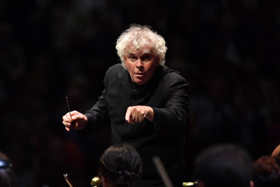Review: PROM 48: SIR SIMON RATTLE CONDUCTS 'L'ENFANT ET LES SORTILÈGES', Royal Albert Hall

![]() Well known for hosting amalgams of works by popular classical and largely unknown modern composers, the BBC Proms has a habit of mixing incongruous musical cocktails. When, on the contrary, the programme is a monograph of one composer's pieces, works are far less likely to refuse to interlock. This evening of Ravel under the baton of Sir Simon Rattle represented one of those less findable occasions.
Well known for hosting amalgams of works by popular classical and largely unknown modern composers, the BBC Proms has a habit of mixing incongruous musical cocktails. When, on the contrary, the programme is a monograph of one composer's pieces, works are far less likely to refuse to interlock. This evening of Ravel under the baton of Sir Simon Rattle represented one of those less findable occasions.
Beginning with the ballet Mother Goose, the motifs of the 20th-century impressionist were showcased both stylistically and rhythmically in the tradition of their subtle beauty. Tones of such pieces happen to be simultaneously bright and timid - reflecting different colours like a sparkling but translucent prism unveils shades of rainbow through a passing light.
Despite some tentative gurgling among uneven flutes, under Rattle's lead each limber section of the London Symphony Orchestra emanated a sly personage. A solo bassoon filtered its motif through the polyphony in a serpentine, stealthy fashion; strings rose and fell in volume with the lightness of a canopy's thin awning being tugged by wind. Although some misfits in the brass rumbled inelegantly, for the most part the piece's changing elasticity and switching textures cast a set of iridescent rays across the audience.
More portentous, Stravinsky-like themes percolated the aura with the song cycle Shéhérazade. Magdalena Kožená's voluptuous mezzo carried the melodies with rhythmic and dynamic accuracy, but mostly stayed far from creative audacity.
With certain motifs consisting of words sung to one note, strange intervals and the fantastical nature of the Scheherazade theme, the voice to match these works should function almost like a 20th-century, obscure percussion instrument - a pitch bend with its warped glissandi - than the natural human facet that it is.
In this vein, while Kožená applied apt accentuation to various seductive phrases, such as a slow diminuendo lining "Comme un mystérieux baiser" - "Like a mysterious kiss" - she could have also made far greater use of portamenti, much slower diminuendi, and more exploratory highlighting of select syllables. Rattle's conducting, by extension, could have dared to be a little more experimental with the rhythms of the eerie melodies that languorously unwind through the work.
L'enfant et les sortilèges, a lyric fantasy of an opera, fits another bill of music altogether. Consisting of many a tongue-twister, onomatopoeic sounds, repeated words and miaows, the story of how boredom prompted an impetuous young boy to decimate the contents of his house - only to have all its amenities retaliate with vengeance - is best presented in a guise adorned with stage design, bulky costumes and both special and visual effects.
Here in a concert staging with its singers in black tie and evening gown attire, the mini-opera's minimalist presentation inadvertently derides it. While Kožená's young boy is dressed in a sailor costume evoking the period, the other characters - of Armchair, Louis XV Chair, The Grandfather Clock, Black Cat and many others - all perform in their own formal clothes, standing and sitting in the custom of the genre.
The music swerves in too many directions to arrive at a thematic consistency - and at various points might resemble a French, modern take on Peer Gynt; adventurous grievances of furniture and animals were here performed in these restraining circumstances.
With absence of theatre to serve the absurd in the music, the performance of this children's fantasy becomes a contradiction of itself. Kožená lends frenetic accents to the boy's outpourings - capturing his style more closely than the trance-like vocal image of her songs in the first act.
In the role of The Armchair, David Shipley's cavernous bass offers appropriate mockingly declamatory tones; the patronising mother makes a palpable appearance in Patricia Bardon's mezzo. Tenor Sunnyboy Dladla lends the music its offbeat and humorous punctuation as The Teapot, The Little Old Man and The Tree-Frog.
Under Rattle's baton, the orchestra's unorthodox usage of instrumental texture and reliance on jarring percussion - including a wind machine and a cheese grater - effuses fresh waves of mischief. And yet the paradox between a narrative of fulgurant and horrifying magic tricks and the contained and almost rigid circumstances of their demonstration is one simply too conspicuous to miss.
Overall, the evening pays sufficient tribute to Ravel to echo the peculiar idiosyncrasies that tie his notes into these chains of brisk rebellious themes and long, meandering motifs. He may have laughed, however, at its lack of avant-garde.
Photo credit: Chris Chistodoulou
Reader Reviews
Videos

